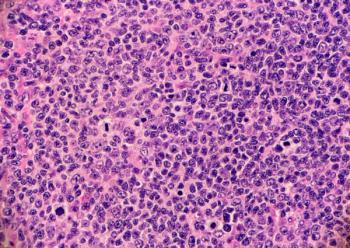
Addition of Olanzapine Improves Complete Response, Nausea and Vomiting Prevention in Chemotherapy-Naive Patients
Study shows efficacy of olanzapine in improving complete response rates and chemotherapy-induced nausea and vomiting in patients receiving moderately emetogenic chemotherapy regimens comprised of oxaliplatin, carboplatin, or irinotecan.
A Phase III trial found that adding olanzapine to moderately emetogenic chemotherapy (MEC) regimens consisting of oxaliplatin, carboplatin, or irinotecan, boosted rates of complete response (CR) and nausea and vomiting prevention in chemotherapy-naive patients.1 The study authors added that these findings, published by JAMA Network Open, indicate that olanzapine should be deemed one of the standards of care for this type of chemotherapy regimen.
“In this randomized clinical trial, olanzapine, 10 mg, combined with aprepitant, palonosetron, and dexamethasone, improved CR rates compared with no olanzapine,” the study authors wrote. “These findings suggest that this regimen could be considered as one of the standards of antiemetic therapy in patients receiving oxaliplatin-, irinotecan-, or carboplatin-based chemotherapy. The use of the [chemotherapy-induced nausea and vomiting (CINV)] risk score should be explored further when making treatment decisions for using [antiemetic prophylaxis (AEP)] in these MEC regimens.”1
A prior study found that the use of olanzapine may help patients with advanced cancer manage symptoms unrelated to chemotherapy, including nausea and vomiting. Olanzapine, a generic drug that treats nervous, emotional, and mental conditions, showed efficacy in patients who had not recently received chemotherapy or radiation therapy but were experiencing nausea and vomiting symptoms.2 The study found that patients administered olanzapine reported less vomiting, increased appetite, and improved well-being while on treatment, with no patient-reported adverse events (AEs).2
“Olanzapine is an atypical antipsychotic agent that blocks multiple neurotransmitters, including dopamine, serotonin, catecholamines, histamine, and acetylcholine, in the central nervous system,” wrote the authors of the current study. “It is approved as part of AEP for highly emetogenic chemotherapy based on Phase III clinical trials. A small Korean study that added olanzapine to dexamethasone and palonosetron as AEP for MEC regimens also showed a decrease in nausea and use of rescue medications for nausea. Based on the philosophy of maximally reducing rates of CINV and the efficacy of olanzapine as AEP in highly emetogenic chemotherapy, the current trial evaluated whether olanzapine would improve (CR) rates in MEC regimens comprising oxaliplatin, carboplatin (AUC≥5), or irinotecan.”1
For the current study, the multicenter, open-label, randomized clinical trial was performed at three institutes in India from March 26, 2019, to August 26, 2023. Investigators enrolled 560 patients aged 18 years or older (259 [64%] male; median age, 51 years [range, 19-80 years]) with solid malignant tumors who were on an oxaliplatin-, carboplatin-, or irinotecan-based chemotherapy regimen. A total of 544 patients had evaluable data, with 274 patients randomly assigned to the olanzapine cohort and 270 randomly assigned to observation, with baseline characteristics evenly matched between both cohorts.
The trial was conducted at three institutes in India from March 26, 2019, to August 26, 2023. The trial’s primary endpoint was CR defined as proportion of patients with no vomiting, no significant nausea (scored as <5 on a visual analog scale of 1 to 100), and no use of rescue medications to treat nausea; with secondary endpoints that included proportion of patients reporting nausea and CINV, use of rescue medications, and AEs.
Rates CR were 91% in the olanzapine cohort compared to 82% in the observation cohort across the overall 120-hour treatment period (P = .005). In terms of nausea control, rates were 96% in the olanzapine cohort compared to 87% in the observation cohort (P < .001), whereas CINV was 96% with olanzapine compared to 91% in the observation group (P = .02) across the overall assessment period.
The proportion of patients administered rescue medications was 4% in the olanzapine cohort compared to 11% in the observation cohort. In terms of safety, grade 1 somnolence was reported by 10% of patients in the olanzapine cohort following administration of chemotherapy compared to no patients in the observation cohort. No additional AEs considered related to olanzapine were reported in the trial.
“Considering that CINV is a major problem with no positive inferences or benefits for patients, allowing such high CINV rates should not be acceptable,” the study authors wrote. “Additionally, if there are efficacious, safe, and cost-effective medications (such as olanzapine) to ensure high CR rates, these medications should be considered for increased patient benefit and evaluated in trials.”1
References
1. Ostwal V, Ramaswamy A, Mandavkar S, et al. Olanzapine as Antiemetic Prophylaxis in Moderately Emetogenic Chemotherapy: A Phase 3 Randomized Clinical Trial. JAMA Netw Open. 2024;7(8):e2426076. doi:10.1001/jamanetworkopen.2024.26076
2. Navari RM, Pywell CM, Le-Rademacher JG, et al. Olanzapine for the Treatment of Advanced Cancer-Related Chronic Nausea and/or Vomiting. JAMA Oncology. 2020. doi: 10.1001/jamaoncol.2020.1052.
Newsletter
Stay current in clinical research with Applied Clinical Trials, providing expert insights, regulatory updates, and practical strategies for successful clinical trial design and execution.




